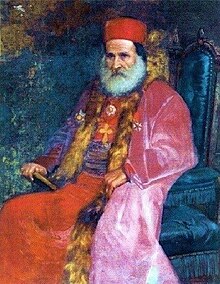Assistant to the papal throne

The Bishops-Assistant at the Pontifical Throne were ecclesiastical titles in the Roman Catholic Church. It designated prelates belonging to the Papal Chapel, who stood near the throne of the Pope at solemn functions. They ranked immediately below the College of Cardinals and were also Counts of the Apostolic Palace. Assistants at the Pontifical Throne, unless specifically exempted, immediately enter the Papal nobility as Counts of Rome.
Pope Paul VI ended the use of this and similar titles of nobility in 1968.
Background
[edit]Prelate Assistants to the Pontifical Throne are distinguished from Prince assistants, who were members of the lay nobility. Prelate Assistants held toward the Pope much the same relation as cathedral canons do to their bishop.[1] Bishops assistants (assistentes solio pontificio) are named by a Brief of the Secretariate of State, and in virtue of their office are members of the Pontifical Chapel (Cappella Pontificia). They assist at Solemn Mass holding the book and the bugia (candle).[2]
History
[edit]All patriarchs and some bishops selected by the Pope, were made Assistants at the Pontifical Throne.[3]
On 22 May 1862, during the canonization ceremony of the twenty-six Catholic martyrs of Japan, Pope Pius IX elevated all the bishops present to the rank of Assistant at the Pontifical Throne. On 8 January 1866, Ruggero Luigi Emidio Antici Mattei was named Dean of the Assistants at the Pontifical Throne after Pope Pius IX named him Latin Patriarch of Constantinople. On 17 June 1867, during the 1800th anniversary of the martyrdom of Saints Peter and Paul, Pope Pius IX elevated all the bishops present to the rank of Assistant at the Pontifical Throne.
The title has not been in use since Pope Paul VI reformed the Pontifical Household. On 28 March 1968, he issued Pontificalis Domus, which renamed the Papal Court the Papal Household and eliminated all titles of nobility.
See also
[edit]References
[edit]- ^ Fanning, William. "Assistant at the Pontifical Throne." The Catholic Encyclopedia Vol. 1. New York: Robert Appleton Company, 1907
 This article incorporates text from this source, which is in the public domain.
This article incorporates text from this source, which is in the public domain.
- ^ Ojetti, Benedetto. "Roman Curia." The Catholic Encyclopedia Vol. 13. New York: Robert Appleton Company, 1912.
 This article incorporates text from this source, which is in the public domain.
This article incorporates text from this source, which is in the public domain.
- ^ "Prelate Named Assistant to Papal Throne", The Catholic Standard and Times, Volume 53, Number 7, 21 November 1947
- New Catholic Dictionary
- Herbermann, Charles, ed. (1913). . Catholic Encyclopedia. New York: Robert Appleton Company.
External links
[edit]| Orders of the Holy See | |
|---|---|
| Orders under protection of the Holy See (with distinctions) | |
| Other distinctions | |
| Defunct/dormant distinctions (selection) |
|
| See also | |
| Jurisdiction |
| ||||
|---|---|---|---|---|---|
| Headquarters | |||||
| Major basilicas | |||||
| Titles Papal names | |||||
| Symbols | |||||
| Proclamations | |||||
| Activities | |||||
| Vestments | |||||
| Transportation | |||||
| Household | |||||
| Staff | |||||
| Related | |||||
Text is available under the CC BY-SA 4.0 license; additional terms may apply.
Images, videos and audio are available under their respective licenses.

